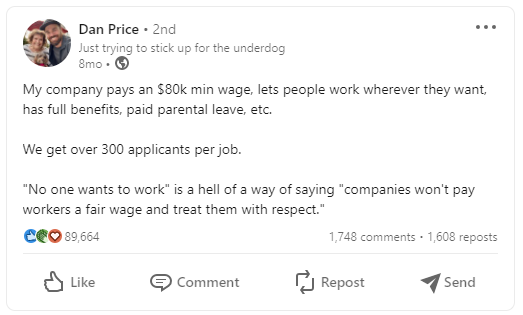Another Dangerous Mindset. Another Short-Sighted Perspective. Another Excuse.

I cannot tell you how many times I have heard business owners and managers say they cannot afford to pay people more. “We’re just a small business.” “Margins are too tight.” “We would lose money or go out of business.” Then they complain that employees don’t care, don’t show up, or don’t last.

Well, my friends, just like anything else in life, you get what you pay for. Labor is no different from any other product or service. Quality costs. I love the meme pictured here. Although it is referring to client-work, the same truth applies when it comes to hiring people.
Rather than balk at paying your people more, let’s look at this another way. By providing a better living for your employees, you are helping people. And you are helping the most important people in your business. Although customers are important, you cannot have customers without your employees. Adopting an abundance mentality has many benefits. In terms of money, realizing that “I/we have enough” is the first step. If you are still in business, then you have had enough money so far. So, you have always had enough. Personally speaking, no matter how destitute you have been in the past, you survived. Even if it was barely, you had enough. More importantly, God (spirit, universe, higher power or whatever you believe) rewards generosity. In other words, by blessing others you will likely be blessed in return (don’t get legalistic with this concept. It’s not a formula.)
Practically speaking, it may not cost as much as you think to pay your people more. You have to consider the true cost of turnover. Lost productivity, worsened customer service, diverted time/energy of management, recruitment costs, and training costs all contribute to the true cost of losing an employee. And while culture is a key component that cannot be ignored, money still talks too.
“According to a 2021 study by the Bureau of Labor Statistics, the average annual turnover rate is 57 percent across all industries, which accounts for both voluntary and involuntary turnover.” Furthermore, “For hourly workers, it costs an average of $1,500 per employee. For technical positions, the cost jumps to 100-150 percent of salary. At the high end, C-suite turnover can cost 213 percent of salary.” –Built In, https://builtin.com/recruiting/cost-of-turnover
For a small business with 2 managers, statistically speaking, you will lose one every year. The cost is approximately 100% of their salary. If you eliminate that turnover, you could afford to give the managers a 50% raise. In other words, paying the 2 managers $60,000 instead of $40,000 would cost the business NO MORE if you keep them both than it would to lose one every year. And $20,000 is hard to walk away from! Obviously, the actual numbers are going to vary from industry to industry and from business to business. Take a little time to calculate your turnover; then take a little more to estimate what this really costs your business.

Still not convinced? Look at Gravity Payments. 5+ years ago, Gravity Payments CEO, Dan Price, instituted a $70,000/yr minimum wage in the company. In August of 2022, when other employers are saying, “No one wants to work,” he said on LinkedIn, “We get over 300 applicants per job.” Do you think they are hiring “warm bodies,” or do they get to choose the best of the best?
I get it. Offering your employees a huge raise is scary. If you are really afraid to make the leap, use the raise as an incentive. “Stay one year, get a XX% raise.” Or at the end of each year issue bonuses based on unspent turnover dollars. Whatever you choose to do, the successful businesses will hire the best people by offering more. More money, more perks, more benefits, and more/better culture. Or keep doing what you are doing and complaining about how nobody wants to work. Gravity Payments and businesses like them who “get it” are more than happy to grab the top talent in your industry.

“You get what you pay for”, has become one of my most favorite sayings in recent times. Companies (and people) will pay either way, whether that be in money OR time, frustration, lost productivity, etc. It really speaks to whether a company is a long term thinking or short term thinking organization when those choices are carefully reviewed. I would be curious how other nations compare in these statistics.